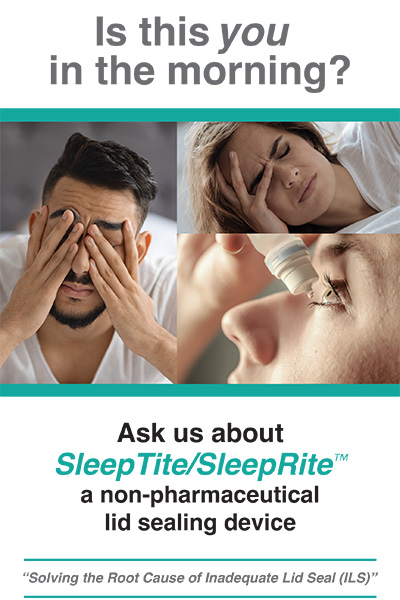Introduction to Inadequate Lid Seal (ILS)
 Numerous conditions such as nocturnal lagophthalmos, FES, Bell’s Palsy, lid laxity, and entropion/ectropion result in the inability to close the eyelids during sleep, which is known to affect dry eye disease symptoms and sleep quality. In most cases, eyelids will close most of the way. However, even a small opening in the eyelids can dry out the eyes. We refer this inability to seal the lids properly as Inadequate Lid Seal (ILS)
Numerous conditions such as nocturnal lagophthalmos, FES, Bell’s Palsy, lid laxity, and entropion/ectropion result in the inability to close the eyelids during sleep, which is known to affect dry eye disease symptoms and sleep quality. In most cases, eyelids will close most of the way. However, even a small opening in the eyelids can dry out the eyes. We refer this inability to seal the lids properly as Inadequate Lid Seal (ILS)
Although, the major sign of Inadequate Lid Seal (ILS) is that your eyelids don’t close correctly, there are also other signs and symptoms, including:
- Eyes that water or are dry
- Feeling like something is stuck in your eye
- Burning or pain in your eye
- Blurred vision
- Red eyes
- Sensitivity to light
Often these symptoms are at their worst in the morning. Over time, Inadequate Lid Seal may damage the cornea from persistent dryness — a condition called keratitis — and increase the risk of corneal ulcers, perforation, and vision loss
Studies have found that people who experience inadequate lid seal have poor sleep quality, mostly likely due to discomfort. Research also indicates that the light entering through open eyelids causes sleepers to awaken from visual stimulation
Contact a healthcare provider if you have symptoms that concern you, like dry eyes, watery eyes or a continual feeling that you have something in your eye. Always contact a provider if you have any change in vision.
If you’ve been diagnosed with inadequate lid seal and you're treating it as directed, contact your provider if symptoms aren’t improving or are getting worse.
Treatment
SleepTite/SleepRite™ is a non-pharmaceutical, mechanical, therapeutic treatment that is used to address the root cause of the inflammation in your eyes. The material is both latex free and hypoallergenic. Each SleepTite/SleepRite box contains 30 pair of single use, interchangeable Lid Seals. Studies have shown that by using SleepTite/SleepRite™ patients can get relief from the discomfort caused by their eyelids not closing properly during sleep. Users have noted that SleepTite/SleepRite™ is well tolerated and gentle on eyelashes and tissue around the eye.
The proper placement of SleepTite/SleepRite™ on your eye will be critical to your success with the product. If you are not accustomed to having your eyes occluded at night it is best to start using SleepTite/SleepRite™ on one eye, until you are comfortable and readily capable of handling its removal and replacement on the eye in the event you have to get up during the evening. Most eye doctors will start the patient off using SleepTite/SleepRite™ on the eye that bothers them the most and have them do that for at least 30 days. This will give you ample time to work out your nighttime routine and also give you experience with the continued proper removal and replacement of the eye seal during actual nighttime use. If you are a patient used to using other products that occlude both eyes, you should still only start using SleepTite/SleepRite™ after you have practiced removing and subsequently reapplying at least one of the devices when you need to get up at night.
Using SleepTite/SleepRite®
1. Thoroughly clean around the upper and lower eye lids, rinse well and dry thoroughly prior to applying SleepTite/SleepRite. The best results come from using a gentle product such as a baby soap or shampoo. Many of the stronger lid cleaners contain a surfactant that could leave a residue. If that is used it is important to thoroughly clean and dry the lids before applying SleepTite/SleepRite.
2. You should NOT use any gels or ointments prior to putting on the SleepTite/SleepRite. The use of gels or ointments can cause the device to lose adhesion during sleep. If you are only using the device on one eye, you can use any recommended medications in the other eye.
3. Once you apply the device on your eye check to see if you are able to see light or a blurry image through SleepTite/SleepRite. You can also wave your hand in front of the occluded eye to test if you see movement. Either method would indicate that the eye is not completely closed and the device must be reapplied. The reapplication should include more firmly closing the eye and at the same time raising the tissue/skin of the upper eye lid so that the SleepTite/SleepRite is not adhered to any redundant skin.
4. Keep the card from which you removed the SleepTite/SleepRite on your nightstand. If you need to get up you can remove the device and gently place it with the adhesive side down. Simply put the eye seal back on when you return to bed.
5. Typically, the patient will place SleepTite/SleepRite on so the tab is located temporally as this is the easiest application to then remove when you awake. If you are dislodging SleepTite/SleepRite while sleeping, try using the device by placing the tab nasally.
6. To remove the SleepTite/SleepRite simply grasp the tab and gently pull towards the opposite direction to where the tab is positioned.
Precautions

- This device is single use only. Reuse of this device may lead to patient cross contamination and/or device failure.
- Care should be taken not to touch the other surfaces with the eye cover before placing on the eye. Doing so could promote cross contamination.
- Any serious incident resulting from the use of the device, please report the incident to us, physician, and your local health competent authority.
